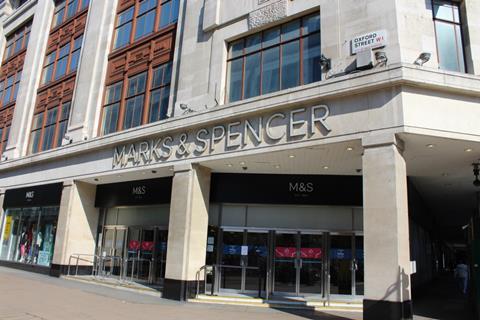Retailer tells public inquiry it will leave 1920s store if proposal to demolish and replace it with office block is not approved
The decline of LondonŌĆÖs Oxford Street would ŌĆ£accelerate dramaticallyŌĆØ if Marks and Spencer is not allowed to press on with its controversial plans to demolish its flagship store, the retailerŌĆÖs lawyer told a public inquiry this morning.
Russell Harris KC described the western end of the street, where M&SŌĆÖs 1920s store is located, as a ŌĆ£failingŌĆØ neighbourhood which already had an unmistakable ŌĆ£smellŌĆØ of decline.
It comes after M&S warned that it would leave the building if its Pilbrow & Partners designed proposals to flatten the site and replace it with a 10-storey office block are thrown out by the government.

The scheme was approved by London mayor Sadiq Khan last year before then-communities secretary Michael Gove, since reappointed to the role this evening by new prime minister Rishi Sunak, called in the plans following a campaign led by Save BritainŌĆÖs Heritage to rescue the building.
Save was then granted main party status at a public inquiry overseen by the planning inspector which got underway today and will continue for the next two weeks, with the result expected to be highly influential for the future of demolish and rebuild projects.
The proposals have whipped up a backlash within the built environment sector and beyond over the loss of the Art Deco building and the much greater carbon impact which detractors expect the scheme will have compared to a refurbishment of the existing site.
The governmentŌĆÖs housing tsar Nicholas Boys Smith said in April that the escalating row over the scheme went ŌĆ£right to the heartŌĆØ of discussions about sustainability and described the case for pulling down the building as ŌĆ£gossamer thin at bestŌĆØ.
SaveŌĆÖs lawyer Matthew Fraser told the inquiry today that the construction of the new scheme would emit nearly 40,000 metric tons of carbon, equivalent to driving a car further than distance to the sun.
Fraser said the plans appeared to contradict government policies on achieving net zero and a series of London Plan policies on avoiding demolition.
But Harris said that the notion the scheme was a test case for how future demolish and rebuild projects would be treated by planners was ŌĆ£nonsenseŌĆØ.
ŌĆ£It is no such thing,ŌĆØ he told the inquiry. ŌĆ£The decision to be made by the secretary of state [Gove] is a planning decision.ŌĆØ
ŌĆ£There is nothing in national nor London Plan policy which requires refurbishment of a site in preference to redevelopment.ŌĆØ
Harris said the scheme was essential for the western end of Oxford Street to continue to act as a significant commercial centre following the loss of other major department store occupiers on the shopping strip including Debenhams and House of Fraser.
ŌĆ£The west end of Oxford Street is in decline. That decline is obvious and palpable. Go there, it has a smell. A tangible, unmistakable expression of decline. It is a failing centre,ŌĆØ he said.
ŌĆ£Without Marks and Spencer at this failing location, and they will leave if this application fails, the decline of this area of the centre will accelerate dramatically.
ŌĆ£So, too, will its consequent ability to act as a spatially important sustainable location for growth. There is no department store operation in the UK retail market which would come close to being in a position to take the entire site vacated by M&S.ŌĆØ
Fraser said M&SŌĆÖs warning that it would leave the site if the scheme could not proceed was ŌĆ£not the constructive attitude of a retailer dedicated to sustainability, heritage conservation and the future success of Oxford StreetŌĆØ.
He added: ŌĆ£Despite claiming that sustainability is at the core of their brand and committing to being a net zero business by 2040, M&S have dismissed the creative refurbishment alternative to such an extent that they have made a threat to the Secretary of State to leave Orchard House altogether if they do not get their way.ŌĆØ
The inquiry also heard from several third party witnesses, including London Eye architect Julia Barfield, who described the project as ŌĆ£throwing a huge carbon bomb unnecessarily into the atmosphereŌĆØ.
ŌĆ£I think we can all agree this morning that we are in a planetary emergency. Westminster council, the Greater London Authority and the UK government have all declared,ŌĆØ she said. ŌĆ£What I think is at issue at this public inquiry in 2022 is ŌĆō are we acting as if there is an emergency?ŌĆØ
Barfield, who is managing director of Marks Barfield Architects and one of the founders of environmental campaign group Architects Declare, said that ŌĆ£everything needs to changeŌĆÖŌĆÖ given the scale of the climate crisis.
ŌĆ£As architects, I believe that we also have a higher responsibility to the planet as well as to our clients ŌĆō as do clients, by the way.
ŌĆ£It is disappointing that one of the countryŌĆÖs best-loved retailers appears not to be taking a lead on climate.ŌĆØ
Gove will ultimately determine whether the plans can proceed, based on the advice of the planning inspector who presides over the public inquiry.




























No comments yet